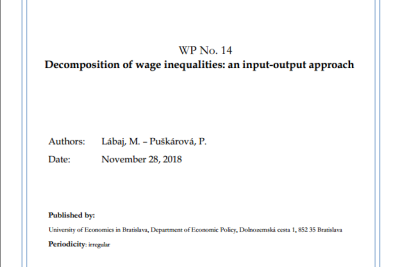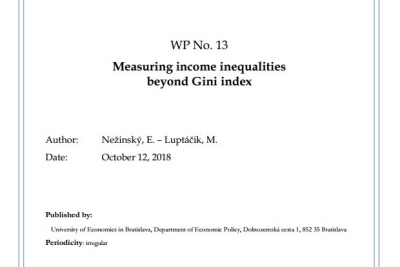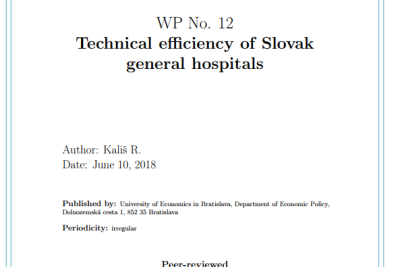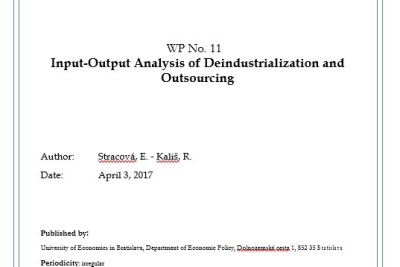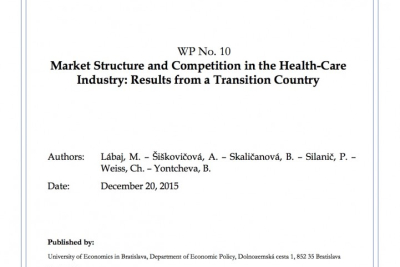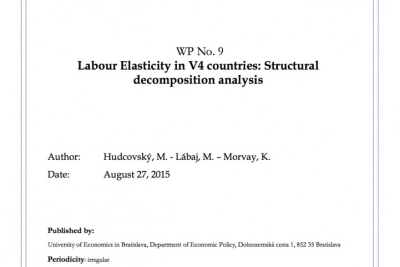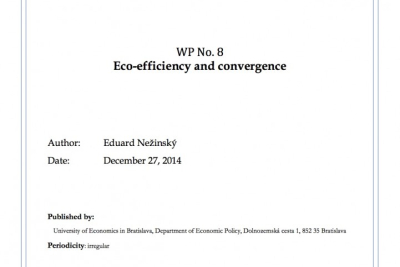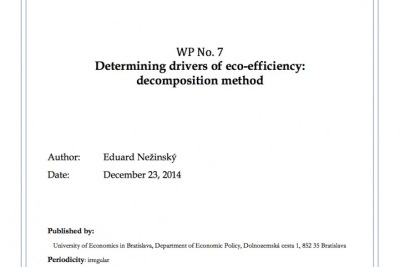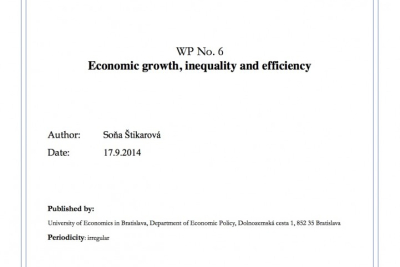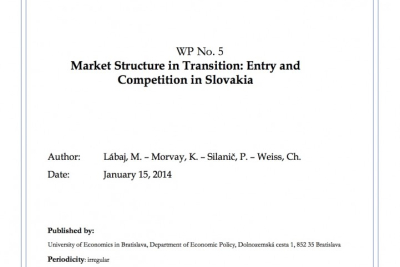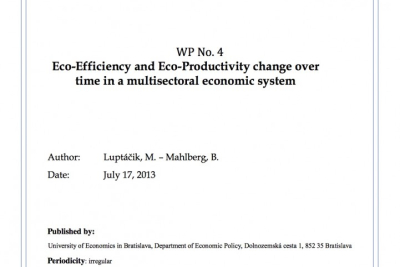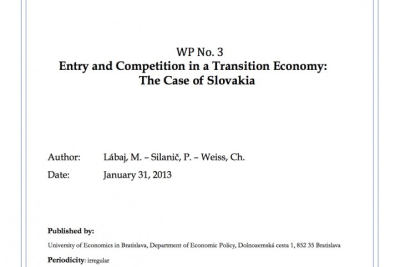Abstract
Income and wealth inequalities, both between and within the advanced and developing countries, have attracted much attention in current economic debates. Wage inequalities appear to play a key role in the generation of final inequalities in terms of households’ income, consumption and wealth. In this paper, we propose a decomposition approach based on the input-output analysis that allows us to disentangle the effects on the final inequalities’ levels into the contributions of various determinants. So far, the analysis of income and wealth inequalities measured by standard inequality indices, e.g. Gini coefficient, Theil index, has received limited space in the input-output analysis. This does not imply that issues of income and wealth inequalities have been ignored in this stream of research. The focus of the input-output research has however been directed into distinct aspects of inequalities. In one way, researchers have put a lot of effort in the understanding how the income and wealth inequalities influence the structure of final demand of households, and eventually generate ambivalent effects on production, value added and employment. Other stream of research in input-output analysis has paid a lot of attention to inequalities that arise from the distribution of income that goes to labour and capital. We propose to calculate cross-industry and cross-country wage inequalities directly from the input-output tables and analyse the final inequality variations through the lens of changes in the inputs. Detailed industry-level data on employees’ wages linked to their hours worked and education attainments, which are covered by the World input-output database, allow us to illustrate the application of proposed methodology on major advanced and developing countries in the world. The analysis contributes to solving the puzzle around the impacts of human capital and technological progress on income inequality but may shed also more light on the rising global inequalities unfolded by international trade and fragmentation of global value chains.
- Návštevy: 309
Abstract
Growing interest in the analysis of interrelationships between income distribution and economic growth has recently stimulated new theoretical as well as empirical research. Since existing theoretical models propose inequality is detrimental to growth, while others point at income inequality as an essential determinant supporting economic growth. Measures such as head-count ratio for poverty index or widely used Gini coefficient are aggregated indicators without deeper insight into income distribution among the poor or the households. To derive an indicator accounting for income distribution among the income groups, we propose output oriented DEA model with inputs equal unit and weights restrictions imposed so as to favour higher income share in lower quantiles. We demonstrate the merit of this approach on the quintile income breakdown data of the European countries. Prioritizing lower income groups´ welfare, countries – e.g. Slovenia and Slovakia – can be equally favoured by the new proposed indicator while assessed differently by Gini index. Intertemporal analysis reveals a slight deterioration of income distribution over the period of 2007 – 2017 in a Rawlsian sense.
- Návštevy: 245
Abstract
In this study, technical efficiency of Slovak general hospitals was investigated. The well-known non-parametric Data Envelopment Analysis was used to compare performance of Slovak health care providers. Results are based on four slightly differentiated models. Both CRS and VRS variation with different input approaches were used. Our results suggest low average efficiency in Slovak hospitals in the range 0.45 to 0.62 with great variations in efficiency score between individual Decision Making Units (DMUs). These results are relative without appropriate cross-country comparisons. Furthermore, in type of hospital entity there is no significant difference in efficiency score. However there is not a single efficient DMU in a group of municipality hospitals. Although, these results must be taken with caution due to questionable quality of data, this paper provides some valuable overview on technical efficiency of health care providers.
- Návštevy: 162
Abstract
The paper deals with the topic of deindustrialization as a process of a decreasing relative importance of manufacturing. While the decrease of manufacturing in major developed and developed economies is undeniable, the developing and newly industrialized economies are starting to experience this phenomenon as well. The results of the paper show that the so-called premature deindustrialization is mainly caused by outsourcing. Furthermore, the data suggest the existence of an upper limit of outsourcing for major developed economies. In these economies, the decrease of manufacturing is more likely caused by other relevant factors. Last but not least, a few transition economies face to a slightly decreasing value of outsourcing on a much lower level. This could be explained by a fragmentation of the entire value chain across the European Union. The empirical results are based on the Input-Output methodology, the observation period of fifteen years from 2000 to 2014 and a sample of 43 countries.
- Návštevy: 322
Abstract
The present paper provides first empirical evidence on the relationship between market size and the number of fi rms in the health-care industry for a transition economy. We estimate market size thresholds required to support diff erent numbers of suppliers (fi rms) for three occupations in the health-care industry in a large number of distinct geographic markets in Slovakia, taking into account the spatial interaction between local markets. The empirical analysis is carried out for three time periods (1995, 2001 and 2010) characterizing diff erent stages of the transition process. Our results suggest that the relationship between market size and the number of fi rms diff ers both across industries, and across periods. Furthermore, we fi nd evidence for correlation in entry decisions across administrative borders.
- Návštevy: 4308
Abstract
In the present paper, we analyse determinants of labour elasticity in V4 countries. While the standard approach relies on the parametric estimation of labour elasticity coefficients, we employ a novel approach based on structural decomposition analysis. This allows us to identify several determinants that mitigate the effects of economic growth on employment. We decompose the overall change in employment into the contribution of six factors: changes in labour productivity, changes in import of intermediate products, changes in the structure of production, changes in the final demand structure by industries and by sectors, and a change in final demand volume. We show that besides generally accepted influence of labour productivity growth on employment other factors such as structural changes and changes in final demand played an important role in employment changes. These results shed some light on low labour elasticity in V4 countries that goes beyond the simple labour productivity growth argument.
- Návštevy: 2003
Abstract
In pursuit of welfare, environmental issues constitute one important dimension to be taken into account in assessing the welfare along with the economic and social indicators. There has been a lively discussion about measures of social welfare beyond GDParticulated by Stiglitz Report (Stiglitz et al, 2009) which can be viewed as a summation of the earlier efforts to deal with those challenges. This study concentrates on environmental aspects of economic growth in European countries and the changes undergone in the period of 2000 – 2010. Time series of obtained eco-efficiency scores from SBM models were used to infer on the s- and β-convergence analysed in line with the classical econometric approach. Results suggest that except of the post crisis disruption a process of convergence with respect to eco-efficiency has been taking place in European countries.
- Návštevy: 437
Abstract
There has been a lively discussion about measures of social welfarebeyond GDP induced by Stiglitz Report (Stiglitz et al, 2009) which can be viewed as a summation of the earlier efforts to deal with those challenges. Environmental indicators constitute one important dimension to be taken into account in assessing the welfare along with the economic and social indicators. Employing non-parametrical approach, the Data Envelopment Analysis SBM model is extended for environment to measure the so called eco-efficiency. Resulting scores and benchmarks are used to decompose eco-productivity into factors attributable to changes in efficiency, technology, extensive factors of production, and emissions. Results suggest that in European countries in the span 2000 – 2010, an environment-saving rather than input-saving technology change has been taking place.
- Návštevy: 115
Abstract
Over the last decades, theoretical work has come up with a significant amount of concepts how the income inequality and economic growth may affect each other. The recent literature identifies many channels through inequality may have positive, negative or even both effects on economic performance, but in different time dimensions.The relationship has been researched from the both perspective: the impact of income inequality on economic growth, and how the economic growth and efficiency are related to income inequality. Despite of the amount of theoretical and empirical work, the relationship between efficiency and equality is far from being well understood.
- Návštevy: 230
Abstract
The present paper provides first empirical evidence on the relationship between market size and the number of firms for a transition economy. We estimate size thresholds required to support different numbers of firms for seven retail and professional service industries in a large number of distinct geographic markets in Slovakia. The empirical analysis is carried out for three time periods (1995, 2001 and 2010) characterizing different stages of the transition process. Our results suggest that the relationship between market size and the number of firm has changed substantially over time. While entry threshold ratios tend to be larger than one and decline with the number of firms in most professions in 1995, the estimation results obtained for 2010 suggest entry threshold ratios much closer to one. This finding is consistent with observations suggesting a significant decline in entry barriers as well as an intensification of competition over time.
- Návštevy: 194
Abstract
We measure eco-efficiency of an economy by means of an augmented Leontief input-output model extended by constraints for primary inputs. Using a multi-objective optimization model the eco-efficiency frontier of the economy is generated. The results of these multi-objective optimization problems define eco-efficient virtual decision making units (DMUs). The eco-efficiency is obtained as a solution of a data envelopment analysis (DEA) model with virtual DMUs defining the potential and a DMU describing the actual performance of the economy. In this paper the procedure is extended to an intertemporal approach in the spirit of the Luenberger productivity indicator. This indicator permits decomposing eco-productivity change into eco-efficiency change and eco-technical change. The indicator is then further decompounded in a way that enables us to examine the contributions of individual production factors, undesirable as well as desirable outputs to eco-productivity change over time. For illustration purposes the proposed model is applied to investigate eco-productivity growth of the Austrian economy.
- Návštevy: 155
Abstract
The present paper provides first empirical evidence on the effects of entry on market conduct for a transition economy. We estimate size thresholds required to support different numbers of firms for seven retail and professional service industries in a large number of distinct geographic markets in Slovakia. Our results suggest a differential impact of entry on market conduct: while market conduct is unaffected by entry in the north-western parts of Slovakia, competition tends to kick in slowly in most professions in the south-east. This latter region suffers from infrastructure bottlenecks and competitors require a larger increase in the number of customers to come in.
- Návštevy: 185
Strategický partner
Hlavní partneri
Partneri
